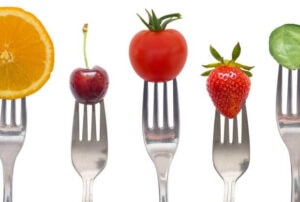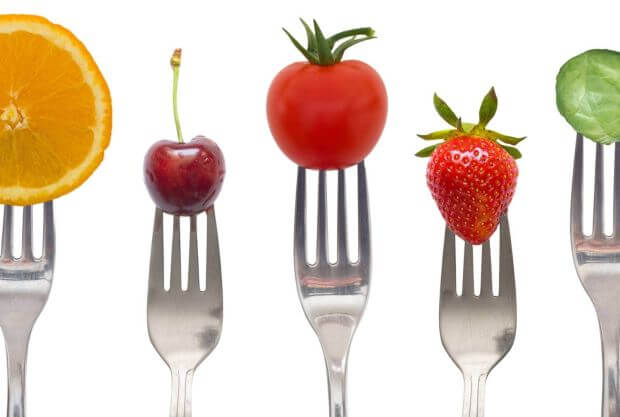The eatwell plate clearly shows the five food groups which provide all of the essential nutrients that we need to function. In addition the plate also shows the proportions in which we should eat food from these groups to provide that healthy diet.
Each of these five food groups shown in the image above (UK Food Standards Agency) provides a different range of essential nutrients. No single food or food group will provide all the nutrients that we need. What we need to do is to follow a balanced healthy diet making sure we have the healthiest option from all the food groups.
Looking at the proportions in the eatwell plate, ask yourself if you are eating these amounts of food:-
Fruit and Vegetables – recommended amount is 5 per day. A portion is a roughly a handful or around 80g. You should aim to have at least ¼ of your plate with vegetables. And if you are trying to lose weight ½ of your plate. Aim for fruits and vegetables which have a lower glycaemic index (GI) such as apples, pears, broccoli or peas. This food group provides us with vitamins, minerals, antioxidants, folate, fibre and water. Fruit and vegetables are also naturally low in fat and calories.
Bread, rice, potatoes, pasta and other starchy foods – each of your 3 main meals should contain at least ⅓ of food from this group, but less, e.g. only ⅕ if you are trying to lose weight. Choose wholegrain foods such as oats, wholegrain bread and again those options which have a lower GI for example brown rice and sweet potatoes rather than white potatoes which have a higher GI. This food group provides us with protein, several B vitamins (thiamine, riboflavin, niacin and folate), minerals (iron, magnesium, and selenium), energy and fibre.
Meat, fish, eggs, beans and other non-diary sources of protein – each of your 3 main meals should be ¼ of food from this group or slightly less e.g. only ⅓ if you are trying to lose weight. Choose lean meats such as turkey breast, or chicken. Aim to eat at least 2 portions of fish per week, 1 oily type (e.g. salmon) one non-oily type (e.g. cod). This food group provides us with protein, vitamins and such minerals as iron, zinc and magnesium.
Milk and dairy foods – 2 to 3 portions of this food group per day are recommended, however it depends largely on your age. An example of a portion would be ⅓ pint of milk. Choose skimmed milk as the healthiest option. Small pots of low fat yogurt or about 25g – 30g portion reduced fat cheese would also be suitable for everyone. This food group provides us with calcium, potassium, vitamin D and protein.
Food and drinks high in fat and/or sugar – this is the food group where we should look to reduce / and or have as little as possible from. We should consider foods from this group as occasional “treats” as overeating these may be detrimental to our health. We should cut down on butter, oils, sugary drinks, cakes, biscuits and sweets. These types of foods are usually high in calories and promote weight gain. For someone on a calorie controlled diet, these foods should be avoided as the nutrients provided in this food group can be obtained from the other food groups above.
Next to Carbohydrates



